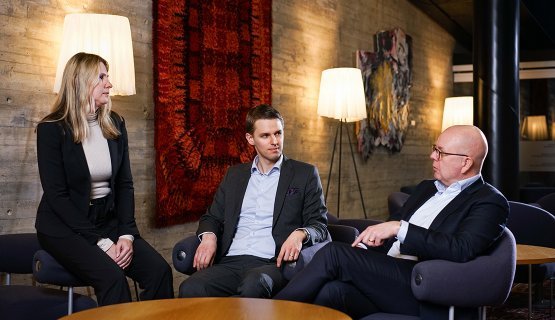“It all started with the idea that it might be beneficial to train the logistics teams and ensure that everyone is on the same page,” Metsä Group’s SVP, Corporate Affairs and former Logistics Director Jari Voutilainen says.
Voutilainen discussed this idea with Vice President, Sales and Marketing, for VR Transpoint, Martti Koskinen, who invited Voutilainen to contact SSAB Europe Head of Supply Chain Management & IT, Tarja Kemppi.
The idea was finally developed into a consortium of three companies, which together with Aalto EE designed a joint logistics training program.
“The intention was that we would do benchmarking at the same time, and exchange ideas about shared issues with different companies. It’s easy to become blind to your own way of thinking. Sometimes it’s good to step out of your bubble and see that there are other perspectives,” Kemppi says.
It’s easy to become blind to your own way of thinking. Sometimes it’s good to step out of your bubble and see that there are other perspectives.”
According to VR Transpoint Head of Business Development, Ilkka Anttila, when you discuss issues together with other companies, you can also compare your own performance to others and see whether you reach the bar or not.
“In logistics today, it’s critical to focus on technology development. On the other hand, technology also involves a lot of hype. When you have a chance to talk with other companies, you get to see what the other companies are actually doing and what sort of challenges there are,” Anttila says.
According to him, it’s important that such training, which is tailor-made for several companies, has both suppliers and customers taking part.
“In principle, we all probably understand what is important to the customer. But when you get to talk about these issues with more people, it generates better understanding,” Anttila says.
Learning from others as important as the subject matter
Each company sent between 5 and 12 people from very different backgrounds for the training. The training program had three different modules, and took about six months in all.
During that time, the participants built the groundwork for common terminology and understanding, went through the current and future prospects of the logistics sector through theory and practice, considered the importance of interaction skills and the impact of communication in the different interfaces of the logistics path, and did joint project work across company borders.
The participants were free to share their ideas, because the companies involved were not competitors.
“It was inspiring, new, and refreshing,” Jari Voutilainen says.
“Training by itself does not necessarily help you find the right solutions or application areas, but it helps to understand that there are issues you should look into more deeply and see whether they might be useful."
Tarja Kemppi felt that learning from other companies and about their practices was at least as important in the training as the matter at hand itself.
After the training, we have been thinking about the internal development of the organization and how to change processes."
“Everyone doesn’t need to reinvent the wheel by themselves. We can do it together. We can learn from each other how things are done, and consider, for example, cost-effectiveness solutions together. You don’t always realize what kind of information is important to the other party and what challenges they might face in their operations,” Kemppi says.
According to Kemppi, the new contacts made during the training were also particularly important, and the participants have stayed in touch.
“After the training, we have been thinking about the internal development of the organization and how to change processes. We can draw inspiration from the people who took part in the training and the contacts we made,” Kemppi says.
“A successful outcome was made possible by the active involvement of all the companies in the steering group work,” says Head of Thought Leadership and Design Raija Kuokkanen from Aalto EE, who was heading the program design and implementation.
The working group met three times before the start of the program and three times during it. The feedback has been enthusiastic, and the intention is to continue working on this basis with another implementation in 2019.













